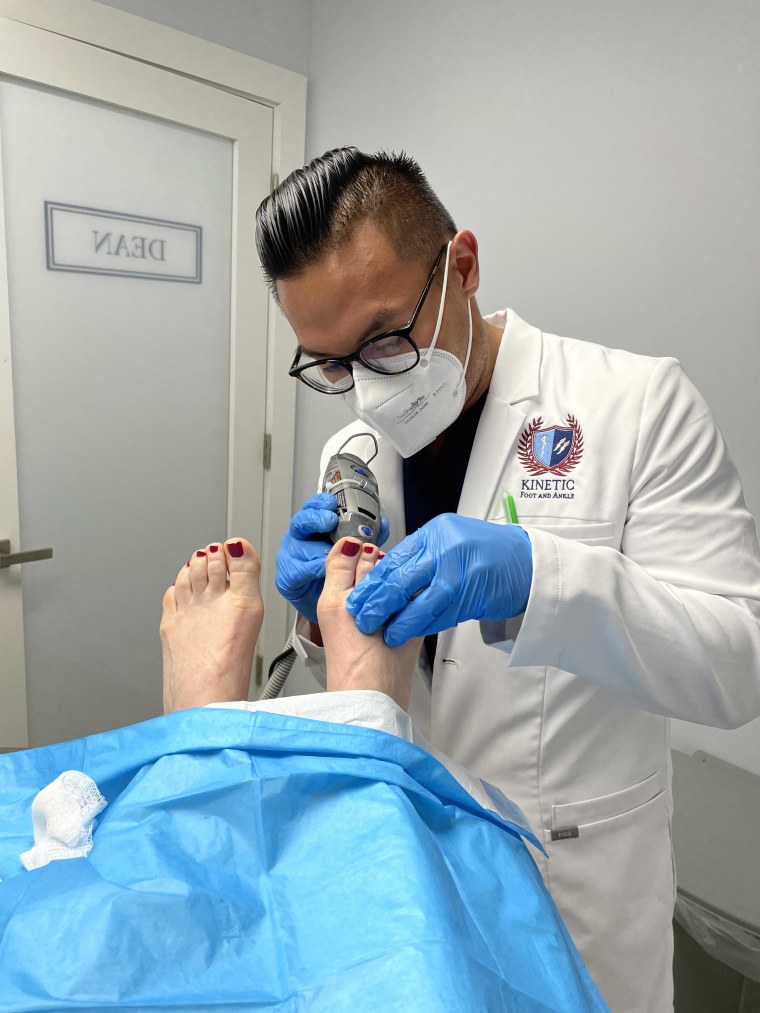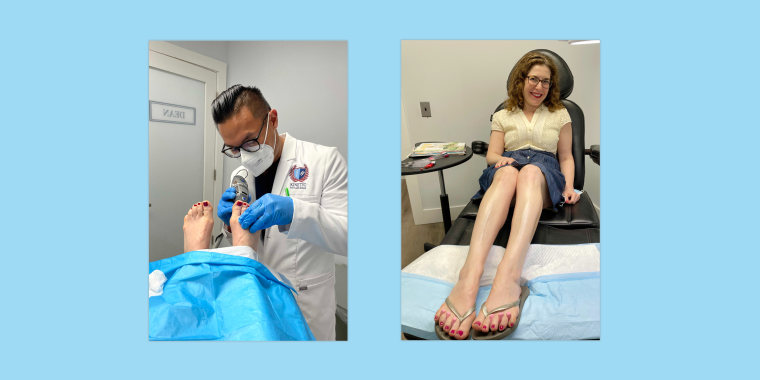For the past few years, I’ve heard about medical pedicures, also known as a medi pedi, and I’ve been intrigued. When it comes to my nails, I’m usually a DIY girl since trips to the nail salon are expensive, plus the level of cleanliness is variable to say the least. Like most people, I’ve been to salons where the environment looks less than sanitary. When you’re not sure how well the tools they use on you are sterilized, or if they are at all, you can easily open yourself up to a nasty infection. So when I heard that you could get a pedicure that’s actually done at a podiatrist's office, I was ready to go.
An online search turned up Kinetic Foot and Ankle and I was immediately drawn to Dr. Rico Visperas’ “Movement is Medicine” philosophy. I noticed a dedicated part of the practice called “Kinetic Aesthetics,” where patients can get a medical-grade pedicure, called the “Kineticure,” performed by a board-certified podiatrist and a licensed nail technician. I booked an appointment at Dr. Visperas’ office in Woodland Park, New Jersey eager to get my feet sandal ready and to finally address the large callus that’s been on the ball of my foot for as long as I can remember.
What’s the difference between a medical pedicure and a regular pedicure?
Visperas told me that the main thing that differentiates a medi pedi from the pedicure you get at your neighborhood salon is that a doctor oversees the treatment and the service is performed under the most sterile conditions. His signature Kineticure is a waterless pedicure where the podiatrist first removes dead, dry skin, corns and calluses. Heels are restored to “baby smooth,” plus the doctor performs a comprehensive foot and ankle screening. After that, the licensed nail technician shapes and trims the nails and performs all the rest of the steps of a traditional pedicure including foot massage and polish.
“We offer a line of polish developed by podiatrists that’s free of the nine common chemicals found in the traditional polish brands,” said Visperas. “Our base coat is a hydrating treatment that helps with thick brittle nails and cuticle oil that helps if you have toenail fungus. “
After watching YouTube videos of podiatrists removing calluses (one I viewed vividly described it as scraping “parmesan cheese” from the foot with a scalpel), I was most excited to get rid of mine. While the callus on the sole of my right foot that starts under the second toe and extends down over the ball doesn’t impede my walking or running, I was curious to know why it was there and get it gone.
Who should get a medical pedicure?
Visperas told me that while a medi pedi can be a great choice for people with certain foot or nail conditions, they’re really for anyone who’s concerned about cross-contamination. “It’s especially recommended for people with diabetes and those who are immunocompromised,” he said. “We don’t double-dip the nail polish brush, all instruments are either sterilized in an autoclave, which is the same procedure the podiatrist uses to sterilize surgical instruments, or they are one-time use. Also, this is a dry pedicure and there is no soaking of the feet, which eliminates any build-up of bacteria.”
I tried it: My experience getting a medical pedicure
When I arrived at Kinetic, I was shown into an exam room. Visperas removed the polish from my toenails and proceeded to do a full examination of my feet and nails, which included a neurovascular test and a biomechanical and dermatological exam. He told me that everything looked great, save for the unstable joint in my right big toe, which he said was the cause of the bunion or small bump protruding from the right side of my foot.

“It’s very common, and nothing to be concerned about unless it’s painful,” said Visperas, but I was still shocked to hear this news. He assured me that my bunion, though not very glamorous sounding, was very normal. “When you walk or run, the pressure deflects from the big toe to your second toe,” he told me. The extra pressure in that spot was the cause of my giant callus. Since calluses are a sign of increased pressure and can sometimes hide underlying medical problems including ulcers or skin abscesses, Visperas said it was best to remove it.
This was the part I had been waiting for! After sanitizing the area, Visperas took out his scalpel and started carving away at my callus. Since a callus is dead skin, the procedure was painless and by the time he was finished the sole of my foot was totally smooth.
Next, Visperas used a nail bur, which looked like a small version of a power sander, to remove the dead skin from the rest of my feet and heels and to smooth out the streaks on my toenails until they too were perfectly smooth. I’ve had salon pedicures before, but this was a whole other level.
Thankfully there were no underlying health issues with my feet or nails, but Visperas says that in doing a medi pedi, he frequently discovers them.
“When someone comes to me for a medical grade pedicure, I am not just smoothing out their heels, I’m also doing a foot screening too,” he said. “Many times, ingrown toenails are discovered where the nails should really be cared for by a podiatrist.” Foot and toenail fungus and warts are other ailments that he often sees.

When Visperas was finished, it was time for the glam. The licensed nail technician took me into another room for the filing, pampering and polishing part of the pedi. Since the medi pedi is totally waterless, there was no soaking your feet in a tub, but the experience was still totally relaxing, complete with a hot stone massage on my feet and legs.
As she shaped my nails with her sterile tools, I picked out a shade of Dr. Remedy’s natural nail polish. Made with a blend of biotin, tea-tree oil, anti-fungal garlic bulb extract, lavender, wheat protein and antioxidant vitamins, the brand offers tons of gorgeous colors (I went with Hopeful Hot Pink!). The polish was poured into a shot glass and a disposable brush was used to avoid cross contamination.
By the time I left Kinetic, my feet were the smoothest they had been since, well, I was a baby, and my toenails had a burst of color that would certainly pop in my sandals. But the best part was that I now understood the anatomy of my own feet (and the peace of mind that came with knowing that my day of self-care wouldn’t come with a course of antibiotics).
Visperas recommended getting a medi pedi every three to four weeks, though how often you go is a personal preference. Since medi pedis are considered a cosmetic procedure, they are not covered by insurance, and they don’t come cheap. My medical pedicure came with a $90 price tag, which is steep for a pedicure alone, but with a complete medical exam and callus removal thrown in, it felt like a steal.
